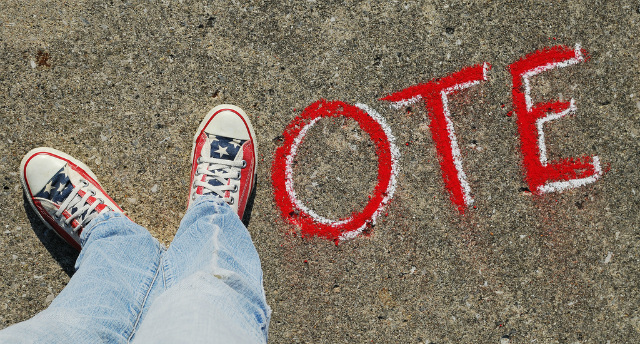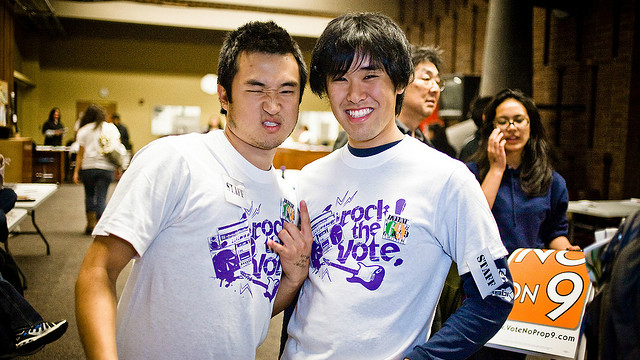What should politicians do to appeal to young voters?

Featured Media Resource: [VIDEO] “Young Voters Want Respect” (Youth Radio)
Eighteen-year-old Youth Radio commentator Amber Ly is a senior in high school and gearing up for voting in her first Presidential election. She’s not too pleased with the candidates’ attempts to be “relatable” to youth. Having grown up during the financial crisis, Ly wants details on their plans regarding student loans and healthcare. She cares about climate change and police violence. But too often, Ly says front-runners are “talking down to young voters” and “wasting time playing guitar or Snapchatting.” While she thinks it’s great that candidates are making efforts to connect with Generation Z, Ly says the problem is, too often they’re trying too hard, skipping over the substance.
Do Now
How should political candidates engage effectively with young voters? #DoNowYouthVote
How to Do Now
Do Now by posting your response on social media platforms such as Twitter, Instagram, Tumblr, Vine, Flickr, Google +, etc.
Be sure to include @YouthRadio, @KQEDEdspace and #DoNowYouthVote.
Go here for more tips for using Do Now, using Twitter for teaching, and using other digital tools.
Learn More About the Youth Vote
It’s a decent time to be a young voter (or soon-to-be voter) in the U.S., at least in terms of sheer numbers. For the first time, there are as many of you as there are baby boomers. So you’re in a position to make a real difference in this election—especially if you live in one of the ten states the research group CIRCLE has identified, where even a small change in the youth vote could make a big difference in the outcome of the Presidential election.
[media-credit name="Carlie Nguyen/Flickr " align="aligncenter" width="640"] [/media-credit]
[/media-credit]
So far in this election season, we’re seeing encouraging signs with respect to young voter turnout. According to the New York Times, youth participation in the primaries so far is rivaling rates we saw when Barack Obama ran in 2008. That said, historically speaking, people between the ages of 18-29 vote at substantially lower rates than every other age group. In the 2012 election, only 45% of 18-29 year old eligible voters voted, whereas 72% of those 65 and older voted.
What could account for these numbers? Lack of interest? Lack of knowledge of the voting process? Or does responsibility fall with politicians, who fail to address issues critical to people in their teens and twenties? There’s also the matter of strategy. You don’t have to look very far to find a slew of embarrassing attempts by presidential candidates to court young voters, like Ben Carson’s rap radio ad, Hillary Clinton’s Twitter campaign to discuss college debt through emojis, or Ted Cruz’s Simpsons impersonation for Buzzfeed.
It’s understandable that today’s candidates seek to replicate the success Barack Obama had connecting with young voters in 2008 and 2012. And of course young people aren’t the only ones who can feel alienated by electoral politics. “If you’re not from a community where voting is the norm, if you’re not from a family where your parents took you to the polling place when you were a little kid, if you haven’t gone to college and developed those cognitive skills,” Professor Melissa Michelson told KQED earlier this month, “then we’re really asking a lot of voters.”
For candidates seeking to get those voters to the polls, finding the right balance between substance and style seems—like so much in politics—is a lot harder than it looks.
More Resources
AUDIO: As Millenials’ Interest in Voting Wanes, Solutions Sought to Re-Engage Them (KPCC)
The race is on to capture the attention of one age group that’s steadily lost interest in voting over the past two decades: young people.
AUDIO: The 10 States Where Millennials Could Sway The Election (NPR)
As the presidential race shifted to Nevada with Democratic caucuses last week and Republican caucuses Tuesday night, more young voters had a chance to chime in to the political process. Nevada is a state with a huge young, diverse population. But there is the perennial question: Do young people matter in politics?
AUDIO: The Father Abstaining from Voting (Youth Radio)
Garrison Pennington reflects on the conflict he felt when he learned that his father, a person he greatly admires, plans to abstain from voting because he “hates partisan politics.”
AUDIO/ARTICLE: What Makes a Person Vote or Not (KQED – The California Report)
This radio piece and accompanying article examine how race, income, age and education play an important role in who votes and who doesn’t.
Do Next
Do Next takes the online conversation to the next level: these are suggestions for ways to go out into your community and investigate how the topic featured in this Do Now impacts people’s lives. Use digital storytelling tools and social media to share your story and take action. Make sure to tag your creations with #DoNowYouthVote.
- Host Your Own Vote: Imagine that two front-runners (from opposing parties or within the same party–your pick!) are planning a visit to your school. Have students come up with two questions they would ask the candidates–one based on a policy issue your students care deeply about, and one that measures the candidates’ youth culture savvy. Then have your class vote on the best questions and tweet them to the candidates. While you await responses (let @youthradio know if you get them!), you could have students research candidates’ positions and personalities, and come up with the answers they’d expect from each one, citing sources for evidence.
- Create a survey: Poll students in your school about the issues they care most about in the upcoming election. Use Youth Radio’s How to Make an Infographic toolkit to prepare them to visualize the survey results in clear and engaging ways. Reflect on what’s most surprising about the findings, and identify candidates’ positions on the issues that came out on top.